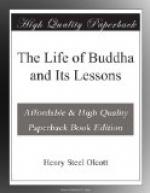I have cited this example for the sole and simple purpose of bringing home to the non-Buddhistic portion of my present audience the conviction that, in considering the life of Sakya Muni and the lessons it teaches, they must not make his followers of to-day responsible for any extravagant exuberances of past biographers. The doctrine of Buddha and its effects are to be judged quite apart from the man, just as the doctrine ascribed to Jesus and its effects are to be considered quite irrespectively of his personal history. And—as I hope I have shown—the actual doings and sayings of every founder of a Faith or a school of philosophy must be sought for under a heap of tinsel and rubbish contributed by successive generations of followers.
Approaching the question of the hour in this spirit of precaution, what do we find are the probabilities respecting the life of Sakya Muni? Who was he? When did he live? How did he live? What did he teach? A most careful comparison of authorities and analysis of evidence establishes, I think, the following data:
1. He was the son of a king.
2. He lived between six and seven centuries before Christ.
3. He resigned his royal state and went to live in the jungle, and among the lowest and most unhappy classes, so as to learn the secret of human pain and misery by personal experience: tested every known austerity of the Hindu ascetics and excelled them all in his power of endurance: sounded every depth of woe in search of the means to alleviate it: and at last came out victorious, and showed the world the way to salvation.
4. What he taught may be summed up in a few words, as the perfume of many roses may be distilled into a few drops of attar: Everything in the world of Matter is unreal; the only reality is in the world of Spirit. Emancipate yourselves from the tyranny of the former; strive to attain the latter. The Rev. Samuel Beal, in his Catena of Buddhist Scriptures from the Chinese puts it differently. “The idea underlying the Buddhist religious system is,” he says, “simply this: ‘all is vanity’. Earth is a show, and Heaven is a vain reward.” Primitive Buddhism was engrossed, absorbed, by one thought—the vanity of finite existence, the priceless value of the one condition of Eternal Rest.




